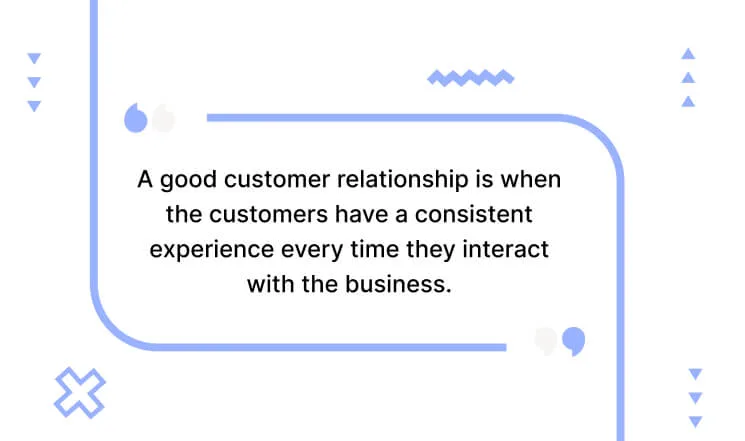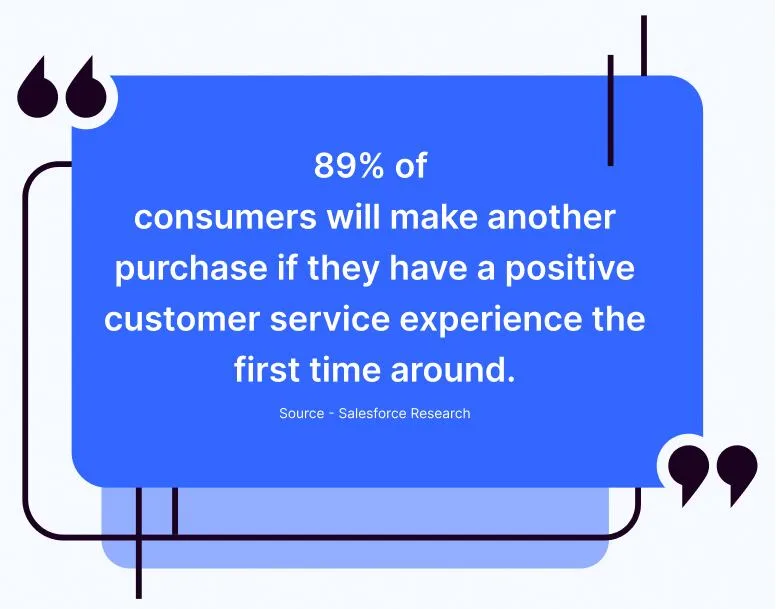Customer Relationships: Definition, Benefits & How to Improve
- February 26, 2020
- 26 mins read
- Listen

Table of Content
Developing a strong relationship with your customers is an effective strategy as it comes with many benefits. This approach shows that you care for customers who, in turn, can stick with the business and make repeat purchases. That’s why retention is often considered a better option than acquisition. In fact, acquiring new customers can cost five to six times more than retaining the existing ones. This is where building long-term customer relationships matters.
More importantly, customer relationships can be a key differentiator in today’s competitive marketplace and it can provide an edge over competitors. When a business focuses on relationships, it sets the foundation for a stable revenue stream over time and stays resilient in tough times.
However, strong customer relationships are not built quickly as they take considerable effort. You also need to invest your time to build and nurture trust in them over time. Businesses that understand the importance of building customer relationships develop an emotional connection with and retain them for a long time. Relationships are the reason why few businesses grow over time, while others have huge swings and eventually descend.
In this blog, we will explore everything about how to build customer relationships and understand the definition of such relations, its importance, and strategies.
Before going further, let’s first get started with understanding what exactly is customer relationships.
What Is Customer Relationship?
‘A company’s or organization’s relationships with its clients or customers are referred to as its customer relationships.’
It is an essential component of any business strategy since it emphasizes creating and sustaining a strong, enduring relationship with customers. Enhancing customer satisfaction, loyalty, and retention is the ultimate goal of customer relationship management because these factors can result in higher profitability and long-term corporate success.

Types of Customer Relationships
Everything a company does should be focused on creating strong connections with its customers. Customer relations is all about how a business interacts with and manages its customers and can be categorized into several types depending on the goals and the nature of the relationship.
Here are the 4 main types of customer relations:
1. Transaction-Focused Customer Relationships
This type of customer relationship is primarily business-focused, centered around exchanging money for products or services. Transaction-focused companies are not concerned with building long-term loyalty or trust. Both the customer and the business are mainly interested in short-term benefits. Customers engage with such brands only when they have immediate needs to fulfill.
2. Emotion-Focused Customer Relationships
Emotional customer relationships are all about connecting with how customers feel in the moment, whether it’s a sense of nostalgia, joy, sadness, or hope. Brands design individual campaigns to spark waves of interest based on these feelings. The aim is to create campaigns and content that form a conscious or subconscious connection between the brand and the customer. This strategy goes beyond meeting basic wants and needs, adding a human element to the brand.
3. Community-Focused Customer Relationships
Community-based relationships tend to be multi-dimensional. While the objective is often to guide customers toward making a purchase, the primary focus is on engaging with both existing and potential customers and creating a positive, long-lasting impression throughout.
Here companies build a community of supporters for higher referral rates and greater involvement in loyalty programs. This community acts as brand ambassadors, who are loyal to the brand and eager to share their positive experiences with others. Building such relationships takes time.
4. Value-Driven Customer Relationships
As the focus here is on addressing customer requirements and their pain points, offering personalization and great customer experience play a vital role in developing this type of relationship. Brands that offer genuine solutions and operate with transparency can easily win the hearts of their customers. By deeply understanding customer needs and educating them on their services, companies can create meaningful, long-term value-added relationships.
Principles Of Good Customer Relationships
A good customer relationship is when the customers have a consistent experience every time they interact with the business. Such interactions leave a good impression on them. It also leads to mutual regard and understanding between the customers and the business, which extends over a long period.
Building strong customer relationships is a strategic decision based on the foundation of providing real-time support and proactively offering solutions that are geared toward customer success. Customer relations aim to create a mutually beneficial relationship with the customer that goes well beyond the initial purchase.

To build good customer relationships you need to:
- Customize your approach with warm greetings depending on the scenario.
- Make your customers feel that you understand what they want.
- Know that some customers are more interested in the ways you build customer relationships than your products or services.
- Keep your customers informed about the things about which they are interested in doing business with you.
Customer Relations Vs Customer Service
Definition: Customer relationship building is a process through which companies develop a positive bond with their customers. On the other hand, customer service is a process through which customers interact with a company and get assistance to their queries. Both customer relations and customer service work hand in hand to offer the best experience to the customers.
Focus: Building customer relations is a long-time process, based on customer loyalty and satisfaction. The focus of customer service is short term, where the support agent offers assistance to customers before, during and after a product or service is purchased.
Goal: While customer relations is about building loyalty and trust, customer service aims to offer immediate assistance to solve and respond to problems and queries.
Importance of Building Customer Relationships
Building strong customer relationships is a strategic approach with a focus on improving customer experience and developing loyalty. A business that prioritizes relationships stays immune to the challenges of the market and stays on top of the industry. The key is to know how to build a relationship with the customer and focus energy on it.
The importance of customer relations has a positive impact on many aspects of the business –
Increased Customer Lifetime Value (CLV)
The longer the customer stays with your business, the greater the value provided during their lifetime relationship. High CLV means each customer will bring in more revenue for your company. When it comes to customer success, you should spare no effort in building strong customer relationships
- Reduced Customer Churn
61% of customers stop buying from a company if they have a poor customer experience. When you adopt the right techniques or even tools and software to build customer relationships, you deliver great experiences, that bring your customers back to you and reduce the chances of customer churn. By delivering the expected service, you stop them from switching to other brands.
- Improved Customer Loyalty
Maintaining strong customer relationships is crucial, as acquiring a new customer can cost way more than retaining an existing one. The level of customer service you provide directly influences customer loyalty. You can effectively enhance customer satisfaction by meeting their demands for exceptional service. Happy customers are more likely to spread positive word-of-mouth recommendations about your brand.
- Word-of-Mouth Marketing
When customers are happy, they turn into brand advocates for the business. Such customers are more likely to share their satisfaction with others and influence their perception of your brand. This can lead to valuable word-of-mouth referrals and organic growth.
- Reduced Customer Acquisition Costs
When businesses build strong relationships with their customers, satisfied customers are more likely to refer friends and family, generating valuable word-of-mouth marketing that reduces the need for expensive advertising. Loyal customers also come to the same brands for repeat purchases, which also reduces new acquisition efforts and costs.
In short, by nurturing positive customer relationships, companies can create a loyal customer base that not only lowers CAC but also enhances overall profitability and long-term success.
Benefits of Customer Relationship
A business that focuses on building relations with customers is more likely to achieve its sales and marketing targets compared to others. In fact, adopting a customer-centric approach can bring benefits to other aspects of the business as well.

Let’s look at some stats to understand customer relationship benefits –
- More than eight out of 10 customers agree that they feel more loyal to brands that respond to them and resolve their complaints. (Khoros)
- 78% of customers can leave a purchase mid-way, or back out of a purchase, due to a poor customer experience. (Glance)
- 89% of consumers will make another purchase if they have a positive customer service experience the first time around. (Salesforce Research)
- Just a 5% increase in customer retention rates can boost profits by between 25% and 95%. (Bain and Company)
How to Build Customer Relationship: 10 Best Ways
Building trustworthy customer relationships requires considering all the interactions across the customer journey and other factors that can influence a customer relationship. Businesses should focus on a comprehensive approach to customer success while planning techniques to build customer relationships.
To do the same, here are 10 key factors that any business should consider for their customer relationship strategies.
1. Exceed Customer Service Expectations
Building long-lasting customer relationships is a smart move from a marketing standpoint. It also helps you anticipate your customer’s needs, perform ongoing adjustment actions to improve your business, and exceed their expectations.
Real-time support is one key attribute of providing a great customer experience. It is a win-win formula for businesses to exceed customer service expectations and create a good impression.
REVE Chat is one such AI powered omnichannel customer engagement platform that allows companies to offer real-time assistance on web, mobile apps and other social media platforms like Facebook, Viber, Instagram, Telegram and WhatsApp. Customers can get in touch with the brands from any of their preferred communication platforms to share their thoughts, concerns and even ask for assistance.
Companies can manage the whole communication process from a single place making customer engagement easy and seamless. REVE Chat also offers an advanced AI chatbot that automates many of the business operations including customer service.
With REVE Chat, companies can offer personalized services to customers based on their preferences, past interactions, buying history, browsing behavior etc. Brands also can get instant customer feedback during and after every live chat interaction making it a great tool to offer the best-in-class services to the customers.
Want to give it a try? REVE Chat offers a 14-day FREE TRIAL to try out all its unique features. So SIGN UP today!
Ritz Carlton Florida sets a great example of creating a memorable customer service experience. One of the family members left their son’s beloved toy Giraffe at the hotel during their vacation, and all his father (Chris Hurn) could do was email Ritz explaining the situation.

The hotel staff responded by not only sending the beloved toy home but also by creating a photo booklet showing everything Joshie had done during his extra stay. If a hotel had done that for your child, would you stay anywhere else?
2. Personalize Customer Relationships
Keeping your customers happy and satisfied is important for all businesses. Connecting with your customers on a personal level is the key to establishing a long and trustworthy relationship with your business. After all, personalization increases loyalty, drives higher conversions, and ultimately increases revenue.
Understandably, the path to personalization for some companies is challenging and as a result, marketers have created segmentation strategies that can help in building a truly personalized experience. With such experiences, you can meet and exceed customer needs and deliver them value at each stage of their journey with your brand.
Consider the below steps to build a good customer relationship and achieve brand success:
- Match Your Tone with Your Customer’s Personality – Some customers prefer short conversations, and some like lengthy ones. You can learn about your customers’ personalities. It will help you to know how to speak and personalize relationships with them.
- Use Advanced Customer Engagement Tools – With live assistance tools like co-browsing and video chat, you can collaborate with your customers in real time and identify issues faster. You can deliver effective, personalized solutions from the first contact. With direct communication, you can build friendlier customer relationships.
- Know Your Customer Preferences – Listen to your customers to identify their needs. Try to learn their preferred contact channels, and how they would like to be addressed. Give your customers the option to choose while enabling them to opt out when they wish. Knowing your customers’ preferences personalizes the experience and builds their confidence in your brand.
3. Understand Customer Psychology
The essence of customer service psychology relates to customer satisfaction. When you understand your customers’ needs thoroughly, you can boost customer satisfaction rates. Customers expect to be valued, listened to, cared about their problems, and want assurance that the same won’t be repeated in the future.
Customer psychology can be analyzed and understood based on their behavior and emotions, which will help you serve them better. The main benefits your brand can gain by understanding the psychology of customers are:
- Customer Loyalty – when customers are satisfied with your service, they become loyal customers and are associated with your brand.
- Brand Advocacy – when you know your customer’s preferences and interests, you can personalize your conversations and build a strong customer relationship. Later, share their success stories and advocate for your brand.
When a customer reaches out to you with a complaint or problem, their expectation is to be heard and get the problem fixed as soon as possible. They expect an attentive ear who acknowledges their problem and delivers the right solution.
4. Prioritize Customer Experience
Customer experience is an integral part of strategies for maintaining and building relationships with customers. Brands with superior customer experiences bring in 5.7 times more revenue than competitors that lag in customer experience.
The three invaluable benefits of building customer relationships that any business can witness are customer loyalty, retention, and referrals. They have a direct impact on the revenue of your business. When customers become loyal, their lifetime value increases, and there are more chances of them recommending you to potential new customers.
Happy and satisfied customers remain loyal. Understand the customer journey and try to deliver a consistent customer experience across the whole lifecycle. The happier your customers are, the more they will retain your business.

This is why delivering superior customer service becomes crucial for businesses. Qantas Airlines, to streamline its operations, invested in the customer experience, and set a great example for other brands.
- Qantas started offering free Wi-Fi on flights that are a rare service.
- Unveiled a faster, streamlined baggage check-in process.
From flight booking to checking a bag, every aspect of a customer’s journey with Qantas was improved.
5. Create Value for Customers
How do you hook a customer for a lifetime?
As a brand, you need to focus on creating value for your customers. And you can do so by:
- Understanding Your Customers’ Needs – Listen to what your customers say, their actions, and reactions to understand what is important to them and look for opportunities to help them.
- Build Communities – Communities can have a tangible impact on key business performance indicators. Businesses gain a significant increase in operational efficiency, revenue generation, and customer satisfaction. Hence, customer communities can be identified as one of the primary techniques for building customer relationships.
- Understand Your Value Proposition – You have to understand what value your products or services create for your customers. What will be their cost in terms of usage? This will contribute to customer relations.
- Invest in Your Valuable Customers – Allocate your business growth towards new products and solutions that serve your best customers. Customers are the lifeblood of your business. They are the source of current profits and the foundation of future growth.
- Educate Customers – Businesses adopt various marketing techniques to lure prospects. Customers are more likely to trust brands that make an effort to enhance their knowledge about their products or services. Research states that educating customers strengthens their trust in an organization, and it can act as an important service differentiator for brands.
6. Instill Customer Service Etiquette
62% of consumers worldwide mentioned they had stopped doing business with a brand after a poor customer service experience. This makes the integration of customer service etiquette crucial in every facet of your business, as delivering superior service is the best way to strengthen customer relationships.
Some key customer service etiquette that you can follow are:
Use Positive Words and Phrases – Customers generally switch brands, when they feel the agents are untrained or rude. 70% of the customer’s journey is dictated by how the customer feels they are being treated. Using the right phrases and words to interact with customers is one of the most important aspects of customer service. Your words create a first impression that goes a long way.
Positive phrases like – My apologies, I am sorry should be used, and negative phrases like – I don’t know, No problem should be avoided.
Practice Active Listening – Always listen to what your customers say. Make the best use of every opportunity to make your customers feel comfortable, valued, and appreciated. Listening completely, without interrupting what your customers have to say helps identify the exact problem. Listening actively helps you figure out what exactly your customers want, their opinions, and their feedback so that you can meet and exceed their expectations
Offer Gratitude– The two mere words ‘thank you’ can do miracles when it comes to customer service. When you use words like “Thank you” and “Please” graciously, it develops a feeling of being appreciated, and the bond between the business and customers becomes stronger.
Show Empathy – Dealing with customers, especially when they are having a complaint or facing any issue, can be resolved much faster and easier by using empathetic statements, being patient, and showing consideration. Using statements like “I realize how complicated it is to…” or “I’m so sorry to hear that…” can help to build rapport by expressing genuine empathy.
7. Provide Multi-Channel Communication Approach
Do your customers know they can reach you with what they need? Do they know how? Strong customer relationships require active communication. It means your customers need to feel comfortable reaching out. You also need to focus on using software for customer relations management so that the chances of poor experiences go away completely.
Let your customers know if you are best reached by email, live chat, social channels, text message, or other forms of communication. You should also know how they prefer to be contacted and be actively available to deliver a consistent experience across all channels. Such experiences are essential as they emphasize the value of how to build strong relationships with customers.
Here are some tips on identifying the channels:
- Understand Your Target Audience – You need to start working out what platforms your customers are using and how they prefer to interact with brands.
- Choose the Right Communication Channels – Whichever channel you opt for, the overall goal should be to drive conversion while also working in tandem with the other channels to provide a consistent and unified experience to customers.
- Focus on Brand Engagement – To sell your brand and create real longevity, you will need people to interact with you. You should focus on conversational engagement across all channels through which customers reach out to you.
- Tailor Your Approach to Channels – A truly successful multichannel strategy needs content specifically tailored to suit each channel. Ensure that the content is different, but the message is consistent.
8. Use Customer Relationship Management (CRM) Tools
CRM is a customer-focused business strategy designed to optimize revenue, profit, and customer satisfaction. The more you understand your customers, the easier it is to target new prospects and boost sales.
Customer relationship management can act as a powerful tool that helps in recording your customer’s product likes and dislikes, their spending patterns, and their location, age, and gender. The CRM software enables you to build up a detailed profile of their tastes, needs, and buying habits. It will help you understand how to maintain good relationships with customers.
A CRM system can benefit your business by helping you centralize, optimize, and streamline your communications with customers and enhance the following areas:
- Gain insights about your customers
- Segment customer base in a better way
- Anticipate their needs & interests through consumer modeling
- Increase customer retention rates
- Faster communication with customers
9. Appreciate Loyal Customers
How do you maintain good customer relationships? Or do you know how to improve customer relationships?
One good way is by appreciating your loyal customers.
Loyal customers are like assets for your business. They improve your brand’s image by becoming brand advocates through good word of mouth. According to Motista, customers with an emotional connection to a brand have a 306% higher lifetime value, stay with the brand for a longer time, and will recommend it at a much higher rate.
Businesses should go the extra mile by building consumer delight ideas and showing appreciation to loyal customers in the following ways:
- Incentivize: Offering discounts, free products, special buying opportunities, and price reductions to loyal customers shows that you value them.
- Premium Services – You can offer premium services to your loyal customers like – co-browsing, video chat, and chatbot support.
- Early Access – The Early Access program is a reward to loyal customers by giving them something exclusive.
Sephora’s Beauty Insider rewards program is globally popular.

- The program records more than 17 million loyal members, and members make up as much as 80% of Sephora’s annual sales.
- Customers earn rewards for each purchase based on a traditional point system.
- The best part is that members can choose how to use their reward points.
10. Acquire Customer Feedback and Act on It
Obtaining customer feedback is one of the techniques used to build relationships with customers.
To serve your customers well, you need their feedback and opinions on what you are doing and what needs improvement. Your customer is the best source of information who can provide you with a genuine picture of your product or performance.
The tips you can follow for collecting customer feedback and acting on it:
- Establish a regular feedback loop in which you ask customers to let you know what is working. This shows them that you are there to understand & serve their needs, not just to build your client base.
- You can ask for feedback at the right time such as after the service conversation ends, after a support ticket is resolved, or a product demo to gain the most genuine feedback.
- You need to obtain customer feedback effectively. Further, categorize and discuss the feedback with respective departments and implement their suggestions. They feel valued, so show them that you are listening to them.
How to Improve Customer Relations?
For long-term success in business, you have to develop a strong relationship with your brand. In the previous section, we explored how to establish this connection. Next, we have listed down some effective strategies to enhance customer relationships further.
-
Be Respectful and Transparent
Welcome every customer with a friendly demeanor and genuine respect. When you show them respect, they are more likely to feel inclined to do business with you.
Moreover, be transparent about the commitments that you make to your customers. For instance, if you assure clients that products will be delivered within five working days, it’s important to make every effort to meet that timeline. If you face challenges to meet the deadlines, communicate openly with the customers about the situation. This transparency not only demonstrates your reliability but can also encourage repeat business.
-
Offer Omni-Channel Customer Support
Customers communicate through various channels, including email, social media, phone calls, and live chat. Ensure your business is present across these platforms and that the messaging is consistent everywhere. REVE Chat can help you out here. It seamlessly integrates all the communication platforms and customer service agents can track and handle all interactions from a single place.
Also, customers appreciate clear communication and instant assistance. Ensure that your responses are prompt and demonstrate that you value their time.
-
Personalize Your Communication
Save customer information so that during your interactions with the same clients, you can look into past conversations, order details, buying behavior, and preferences to personalize your communication. REVE Chat stores all the necessary customer details, enabling agents to access references and tailor their messages accordingly.
-
Stay Connected
Another effective way to nurture customer relationships is by staying connected. There are numerous methods to maintain this connection, such as sending cards for special occasions, adding customers to a mailing list for exclusive deals and discounts on their special days, or following them on social media platforms.
-
Loyalty Programs
These initiatives encourage repeat business by rewarding customers for their loyalty, thus showing a sense of appreciation. You can implement loyalty programs that provide rewards, discounts, or exclusive offers to returning customers, promoting ongoing engagement. Additionally, consider hosting special events or sales exclusively for loyalty program members to further enhance their connection with your brand.
-
Address Customer Concerns ASAP
When a customer offers criticism or shares a negative experience, you can protect the relationship by promptly addressing his/her concerns and providing a solution. Most customers simply want to feel heard and valued. By listening, prioritizing, and offering a suitable resolution promptly, you can not only mend the relationship but potentially make it even stronger.
-
Ask for Customer Feedback
Knowing what customers think about your brand and product offerings is important if you aim to gain customer trust and satisfaction. Use surveys and polls to gather customer feedback and opinions. This shows that you value their input and are willing to make improvements based on it. Also, encourage customers to leave reviews and share testimonials. Acknowledge and thank them for their feedback publicly.
The Key Players in Building and Maintaining Customer Relationships
Building a strong relationship with customers is not the job of a single team. From sales, customer support, product development to marketing all departments are responsible for developing and improving customer relationships. However, there is one customer relations department that helps in the process. Here’s a breakdown of the key players!
1. Chief Customer Officer (CCO)
The CCO leads the customer relations team and manages all interactions that occur between the brand and its customers. They are responsible for creating and implementing different strategies to build and maintain strong customer relationships.
2. Customer Relations Managers
CR managers oversee all other customer relations representatives and their daily interactions with customers. In larger companies or B2B environments, they may also need to handle important clients. CR managers frequently collaborate with the CCO to assess the effectiveness of strategies and identify areas for improvement within the team.
3. Customer Relations Representatives
Customer Relations Representatives are the first point of contact and directly engage with customers through multiple communication channels like emails, phone calls, live chat, messaging, and social media platforms. They play a crucial role in the company’s success, as they receive direct customer feedback and relay those valuable insights to higher organizational levels.
Key Traits of an Exceptional Customer Relations Employee
While making a great customer relations management team, you need candidates who work together to create strong and positive relationships with the customers. Here the customer relations employee should possess some essential qualities that are important not only to improve customer experience but also drive long term success for the business. Let’s look into those qualities!
1. Empathy
The customer relations employee should be empathic and listen carefully to the customers. He needs to understand what customers are going through and offer a response that shows care, making them feel valued and heard.
2. Patience
The customer relations management employee needs to handle difficult or repetitive issues that require a high level of patience. Many times, customers may show frustration and sound rude. But he needs to stay calm and composed, even in challenging situations.
3. Positive Attitude
A positive attitude is essential to handle any situation. When dealing with an upset customer, it’s the perfect moment for a customer relations rep to truly stand out. He needs to be positive and remain focused on resolving the issue and finding a solution.
4. Good Listener
The customer relations rep needs to listen first before offering a solution. Without properly understanding what the customer is going through he will never be able to solve any issue. Using words like ‘I understand’ or ‘Yes, of course’ and repeating the key pointers back to the customers to check if he has understood the problem correctly makes the customers feel heard.
5. Good Communicator
Effective communication is at the heart of building exceptional customer relations. It’s not just about giving the information, but about how the customer relations rep conveys it, ensuring that customers feel understood, valued, and confident in the brand they are doing business with.
6. Product Knowledge
They also need to have a deep understanding of the products or services the company offers, enabling them to offer accurate and helpful advice to customers.
Final Thoughts
Building customer relationships is a critical business objective across the globe. If you want to improve brand engagement, give your customers reasons to emotionally connect with you.
Practically, you have to go beyond CRM and adopt techniques to build and maintain good customer relationships. You can Sign Up with REVE Chat and have the best tools for building customer relationships.
When you have the right tools and customer relationship strategies, it will help you solidify your relationships with customers and create a strong foundation that will help you grow your business to new levels.
Frequently Asked Questions
When companies create positive relationships with their customers, it increases customer retention and loyalty, reduces churn, and boosts word-of-mouth marketing. Satisfied customers often recommend their preferred brands to others, which can attract new leads, increase sales conversions, and grow the overall customer base.
Companies can become trustworthy to their customers by being transparent, consistent, and dependable. This means delivering on promises, providing high-quality products or services, and addressing customer concerns promptly and sincerely. Providing excellent customer service and actively engaging with customers to resolve issues makes customers feel valued, which gradually builds their trust in the company.
Small businesses can build strong customer relationships by focusing on offering personalized services and excellent customer engagement. Here are some key strategies:
Personalized interactions
Active engagement on social media
Loyalty programs and rewards
Instant and helpful customer service
Gathering and acting on feedback for further betterment of services
Gathering feedback from customers and acting on it to make betterments shows that you value their opinions. This not only improves your products/services but also strengthens the relationship by making customers feel heard and appreciated.
The key elements for building positive customer relations include trust, effective communication, personalized experiences, excellent customer service, and consistently meeting or exceeding customer expectations.



